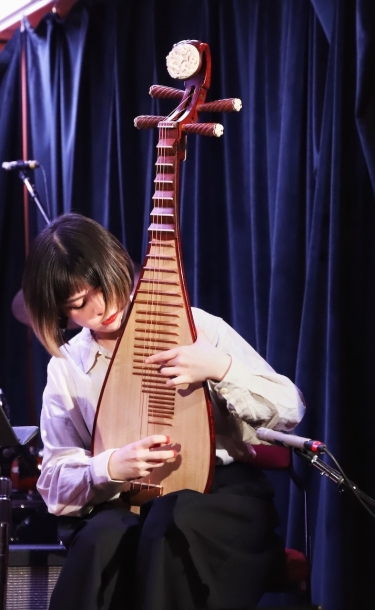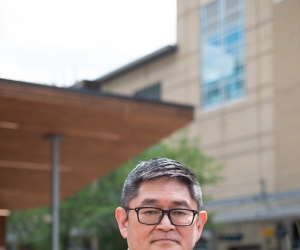
At age five, Ningxin Zhang started her classical training on the pipa—a lute-like plucked Chinese instrument in use for more than 2,000 years—and followed the traditional route of practising repertoire (classical and folk songs) and performing in competitions. While studying translation, interpreting, and intercultural studies at Hong Kong Baptist University, Ningxin was inspired to explore contemporary ideas in music and storytelling through the pipa, and moved to the U.S. to study at Berklee College of Music, where she focused on electronic production and design, and creative coding.
Now studying for a master’s degree at Stanford University's Center for Computer Research in Music and Acoustics, Ningxin is composing electroacoustic music and pursuing research and creative projects related to her current interests: interactive installations for museums and similar institutions, and the use of physical modelling techniques to synthesize the sound of the pipa.
Ningxin talked to Musicworks editor Jennie Punter about some of the discoveries she made at Berklee while experimenting with the pipa and electronics, and about the various sound and story ideas that informed her award-winning piece Kagemusha: for Pipa and Electronics..
This interview has been condensed and edited.
Let’s start with the inspiration for your piece, Japanese filmmaker Akira Kurosawa’s Kagemusha [which shared the Palme d’Or at the 1980 Cannes Film Festival with All That Jazz].
I didn't officially start my musical journey until 2019, and before that I was doing a lot of translation of both Chinese and English novels, and I also did a lot of films and screenplays, so that's why many of my works are inspired by film and novels. Kagemusha is one of my favourite films, and it gave me a lot of inspiration on the creative side, the feelings and imaginative space, when I was composing this piece.
The Chinese pipa has a lot of repertoire describing ancient wars. Asian cultures share this kind of history and have similar repertoire. The pipa repertoire used in this piece is a military tune about a famous war. So I used this traditional form to describe what I imagined from the film.
What were you exploring in your compositional work when you wrote the piece?
I wrote [the piece] two years ago, when I was studying electronic production design at Berklee. We were exploring digital signal processing techniques, sound synthesis, and other techniques that I applied later in this piece.
All the sounds come from recordings of pipa. I wasn't using any other external sounds. Anything you hear that is not the melodies of pipa—all those electronics—are processed by doing a lot of analysis and then synthesis techniques.
Did you suspect that you would be able to get these sounds? Were there some surprises that you discovered as you were working with them?
Some of the techniques I was really familiar with, so I was getting some expected results when I was processing pipa melodies. But I discovered a lot of new things when I was composing it, many beautiful surprises that I used later to form the story of my piece.
I imagine there are subtle things that happen with the materials used to make the pipa instrument too.
Yes! The first string of the modern pipa is a steel string, and the rest are nylon. Just like other string instruments, they have different thicknesses. Some people also like nylon for their first string, but I prefer the crisper sound of the steel string, because that really gives me the strong metallic quality of the pipa timbre. The body of the pipa is redwood, the lower frets are bamboo, and on the top of the neck, the frets are made of jade. Because of all these different materials, I can create my own extended techniques to explore different timbres of this instrument.
There is definitely a journey in the piece that inspires the listener’s imagination. Can you talk about some of the sounds that you were finding and using, and how you put together the storyline of the composition?
I was following the form of the military tune in traditional Chinese pipa repertoire, thinking about it as a storyline. I have nine sections. In the introduction are the melodies that you hear in the composition that I used to create the dark atmosphere of the piece. Then I imagined the history of the ancient war, and the intense relationship between different sides. I described conversations between the sides. At one point, the general of one side got seriously injured. Then the conversations started again, and there were larger fights.
I imagined what happened in the history, and then I did the processing of the melodies at the same time for each section so that the melodies and the electronics have a good balance.
When I'm not actively composing, I play with my instrument and explore more extended techniques. Tapping on the board of the pipa is a really interesting sound, and that could be put at the end of my piece, and those sounds added later for more richness.
Did you know of anyone who was also doing more experimental things with this instrument? Or were you working just in your own little bubble of experimentation?
It’s more like I was working in my own bubble. There are many great Chinese performers and composers, but as far as I know there are very few people experimenting with the pipa in electronic music or electroacoustic music.
I talked to one famous player [We Man], who is a member of Silkroad. She is experimenting in a different way, because she played with musicians from all over the world—she played Chinese music with Indian artists and with European artists playing their traditional instruments. So that's another way to give life to this instrument.
So my work is my way of adding some new culture to this instrument.


